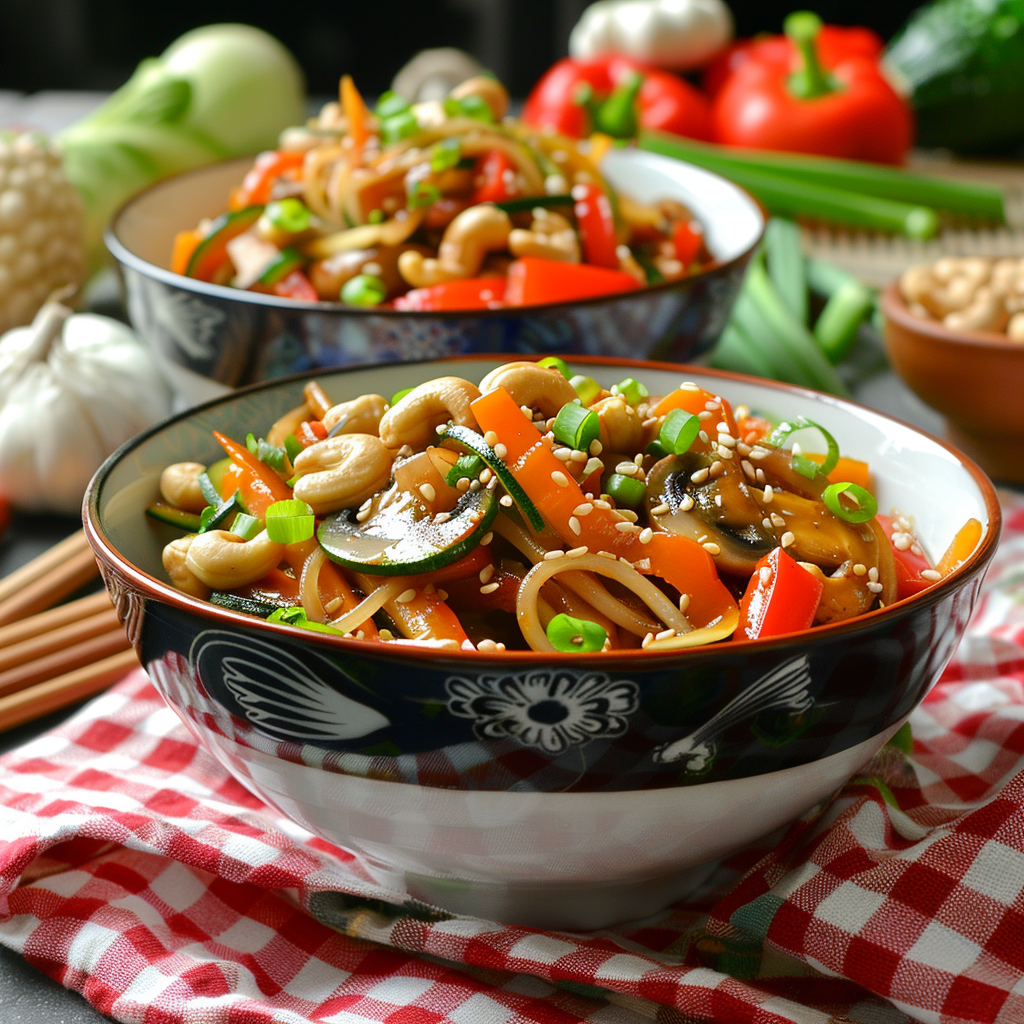Vegan Chinese-Style Stir Fry with Cashews

Share
There's something wonderfully satisfying about preparing a quick and delicious stir fry, especially when it's packed with vibrant vegetables and crunchy cashews. Stir fry dishes are not only versatile but also a great way to use up leftover veggies, making them an economical choice for busy weeknights. The combination of tender-crisp vegetables, soft rice noodles, and toasted cashews creates a perfect balance of textures. And with the right sauces and spices, this dish brings all the flavors of a takeout meal, without leaving your kitchen.
Did You Know?
Stir frying is a traditional Chinese cooking technique that dates back over 2,000 years. It's a quick method of cooking where ingredients are fried in a small amount of very hot oil while being stirred in a wok. This method not only preserves the nutrients in the vegetables but also enhances their flavors and textures.
Yield: 4 servings
Ingredients:
1 cup raw cashews
2 tablespoons vegetable oil
1 cup sliced mushrooms (shiitake or button)
1 large onion, sliced
1 red bell pepper, sliced
1 zucchini, sliced
2 carrots, julienned
3 cloves garlic, minced (or less to taste)
1 tablespoon fresh ginger, minced
1/4 cup soy sauce (or tamari for gluten-free)
2 tablespoons hoisin sauce
1 tablespoon rice vinegar
1 tablespoon sesame oil
8 ounces rice noodles
2 green onions, chopped (for garnish)
Sesame seeds (for garnish)
Instructions:
Prepare the Noodles:
Cook the rice noodles according to package instructions. Drain and set aside.
Personal Tip: Rinse the noodles under cold water to prevent them from sticking together.
Toast the Cashews:
In a large, dry skillet, toast the cashews over medium heat until they are golden brown and fragrant, about 5 minutes. Remove from the skillet and set aside.
Personal Tip: Stir the cashews frequently while toasting to prevent burning.
Sauté the Vegetables:
In the same skillet, heat the vegetable oil over medium-high heat. Add the sliced mushrooms and onions. Stir fry for about 3 minutes until they begin to soften.
Personal Tip: Use a large skillet or wok to ensure even cooking of the vegetables.
Add Remaining Vegetables:
Add the red bell pepper, zucchini, and carrots to the skillet. Stir fry for another 4-5 minutes until the vegetables are tender-crisp.
Personal Tip: Keep the heat high to maintain the crispiness of the vegetables without overcooking.
Add Aromatics:
Stir in the minced garlic and ginger. Cook for about 1 minute until fragrant.
Personal Tip: Add the garlic and ginger towards the end of cooking to prevent them from burning.
Prepare the Sauce:
In a small bowl, whisk together the soy sauce, hoisin sauce, rice vinegar, and sesame oil.
Personal Tip: Adjust the soy sauce and hoisin sauce amounts to your taste for saltiness and sweetness.
Combine Everything:
Add the cooked rice noodles and toasted cashews to the skillet with the vegetables. Pour the sauce over everything and toss to combine. Cook for an additional 2-3 minutes until everything is heated through.
Personal Tip: If the stir fry seems too dry, add a tablespoon or two of water or vegetable broth.
Serve:
Divide the stir fry among four plates. Garnish with chopped green onions and sesame seeds. Serve immediately.
Personal Tip: Serve with extra hoisin sauce on the side for dipping or drizzling.
Nutritional Information (Per Serving):
Calories: 400, Protein: 10g, Carbohydrates: 50g, Sugars: 10g, Total Fat: 18g, Saturated Fat: 3g, Sodium: 900mg, Fiber: 5g
Kitchen Tips, Great Ideas, How to Save Money
- Buying in Bulk: Purchase cashews and rice noodles in bulk to save money. They have a long shelf life and can be used in various recipes.
- Vegetable Choices: Use any vegetables you have on hand. Broccoli, snow peas, or snap peas are excellent additions or substitutes.
- Oil Alternatives: Substitute vegetable oil with sesame oil for a richer flavor. Just be cautious as it has a lower smoke point.
- Spice It Up: Add a pinch of red pepper flakes or a dash of hot sauce for an extra kick.
- Fresh Herbs: Add fresh herbs like cilantro or Thai basil just before serving for an extra burst of flavor.
- Sauce Variations: Experiment with sauces like teriyaki or sweet and sour to change up the flavor profile.
- Meal Prep: Chop all vegetables ahead of time and store them in the refrigerator. This saves time when you're ready to cook.
- Leftovers: Store leftovers in an airtight container in the refrigerator for up to 3 days. Reheat gently on the stove or in the microwave.
- Protein Boost: Add tofu or tempeh for additional protein if desired. Simply cook them in the skillet before adding the vegetables.
- Eco-Friendly Options: Use reusable silicone bags for storing prepped vegetables and leftovers instead of disposable plastic bags.
Let's Learn About Cashews
Cashews are a unique nut because they grow outside of a fruit called the cashew apple, which is native to tropical climates like Brazil, India, and parts of Africa. The cashew nut itself is harvested from the bottom of the cashew apple, encased in a shell that contains toxic oils, making the harvesting process labor-intensive. Workers must carefully remove the outer shell to reveal the edible cashew inside, often by roasting or steaming them to neutralize the toxins.
Raw vs. Roasted Cashews:
You’ll often see cashews labeled as either raw or roasted. Although “raw” cashews are actually steamed during processing to remove their toxic shell, they retain more of their natural flavor and nutrients. Raw cashews are commonly used in vegan cooking due to their creamy texture when soaked, making them ideal for dairy-free recipes like vegan cheesecakes and sauces. Roasted cashews, on the other hand, are cooked with heat and sometimes seasoned, giving them a richer, more intense flavor and crunch, perfect for snacking or adding to stir-fries.
Pesticide Use and Organic Options:
Cashews are not typically heavily sprayed with pesticides compared to other crops. However, it’s always a good idea to look for organic cashews when possible, especially if you're concerned about chemical residues. Organic farming practices ensure that the nuts are grown without synthetic chemicals, offering a more sustainable option for the environment and a cleaner product for consumption.
In summary, cashews are a versatile and nutritious nut, harvested with care and available in both raw and roasted forms, each with its own unique uses. Whether you're enjoying them in a savory dish or a sweet treat, cashews are a delicious and healthy addition to any diet.


